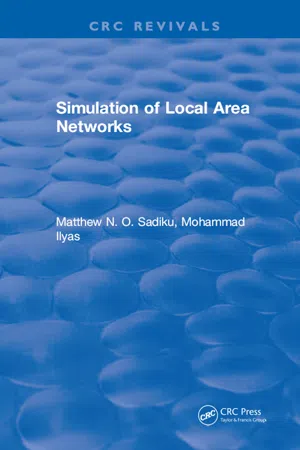
- 212 pages
- English
- PDF
- Available on iOS & Android
Simulation of Local Area Networks
About This Book
A fast-growing area in the communications industry is the internetworking of an ever-increasing proliferation of computers, particularly via local area networks (LANs). The LAN is a resource-sharing data communications network being used by many offices to interchange information such as electronic mail, word processing, and files among computers and other devices. This unique book shows the user how to establish the performance characteristics of a LAN before putting it to use in a particular type of situation. Simulation of Local Area Networks consists of eight chapters, each with its own extensive list of references. The first chapter provides a brief review of local area networks, and the second chapter gives the analytical models of popular LANs-token-passing bus and ring networks, CSMA/CD LANs, and star networks. Chapter 3 covers general principles of simulation, and Chapter 4 discusses fundamental concepts in probability and statistics relating to simulation modeling. Materials in Chapters 3 and 4 are specifically applied in developing simulation models on token-passing LANs, CSMA/CD LANs, and star LANs in Chapters 5 through 7. The computer code in Chapters 5, 6, and 7 is divided into segments, and a detailed explanation of each segment is provided. The last chapter reviews special-purpose languages such as GPSS, SIMSCRIPT, GASP, SIMULA, SLAM, and RESQ. Helpful criteria for language selection are included. The entire code is put together in the appendixes. This book has two major advantages over existing texts. First, it uses C, a well-developed general-purpose language that is familiar to most analysts. Second, the text specifically applies the simulation principles to local area networks. No other book available shows the systems analyst how to evaluate the performance of existing or proposed systems under different kinds of conditions.
Frequently asked questions
Information
Table of contents
- Cover
- Half Title
- Title Page
- Copyright Page
- Dedication
- PREFACE
- Table of Contents
- 1: LOCAL AREA NETWORKS
- 2: ANALYTICAL MODELS OF LAN
- 3: SIMULATION MODELS
- 4: PROBABILITY AND STATISTICS
- 5: SIMULATION OF TOKEN-PASSING LANS
- 6: SIMULATION OF CSMA/CD LANS
- 7: SIMULATION OF STAR LANs
- 8: SIMULATION LANGUAGES
- Selected Bibliography
- Appendix A—Simulation program for Token-Passing LANs
- Appendix B—Simulation program for CSMA/CD LANs
- Appendix C—Simulation program for star LANs
- Index